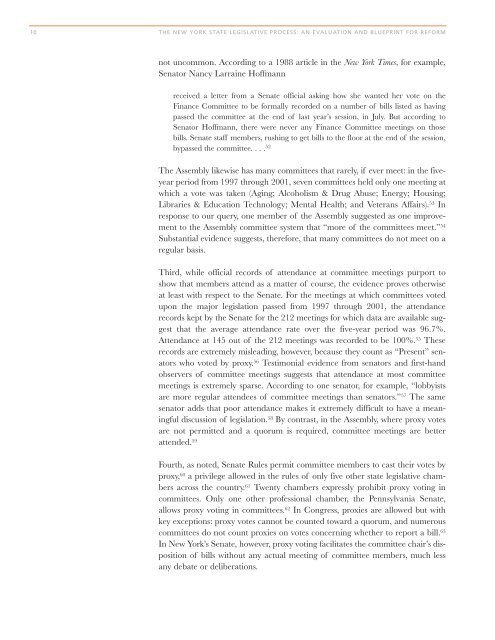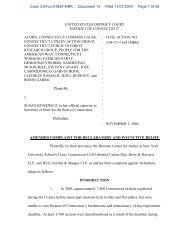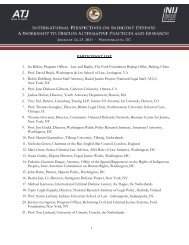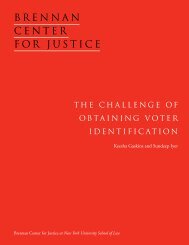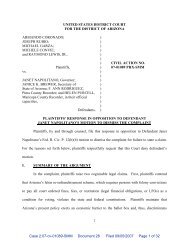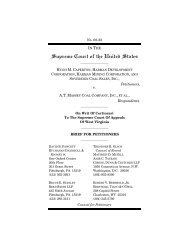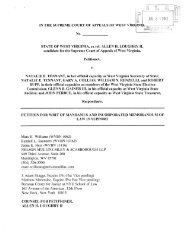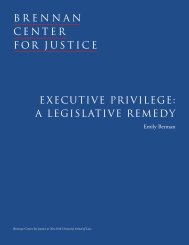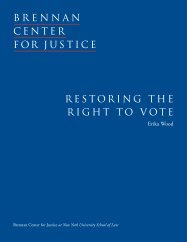THE NEW YORK STATE LEGISLATIVE PROCESS: AN ...
THE NEW YORK STATE LEGISLATIVE PROCESS: AN ...
THE NEW YORK STATE LEGISLATIVE PROCESS: AN ...
You also want an ePaper? Increase the reach of your titles
YUMPU automatically turns print PDFs into web optimized ePapers that Google loves.
10 <strong>THE</strong> <strong>NEW</strong> <strong>YORK</strong> <strong>STATE</strong> <strong>LEGISLATIVE</strong> <strong>PROCESS</strong>: <strong>AN</strong> EVALUATION <strong>AN</strong>D BLUEPRINT FOR REFORM<br />
not uncommon. According to a 1988 article in the New York Times, for example,<br />
Senator Nancy Larraine Hoffmann<br />
received a letter from a Senate official asking how she wanted her vote on the<br />
Finance Committee to be formally recorded on a number of bills listed as having<br />
passed the committee at the end of last year’s session, in July. But according to<br />
Senator Hoffmann, there were never any Finance Committee meetings on those<br />
bills. Senate staff members, rushing to get bills to the floor at the end of the session,<br />
bypassed the committee. ... 52<br />
The Assembly likewise has many committees that rarely, if ever meet: in the fiveyear<br />
period from 1997 through 2001, seven committees held only one meeting at<br />
which a vote was taken (Aging; Alcoholism & Drug Abuse; Energy; Housing;<br />
Libraries & Education Technology; Mental Health; and Veterans Affairs). 53 In<br />
response to our query, one member of the Assembly suggested as one improvement<br />
to the Assembly committee system that “more of the committees meet.” 54<br />
Substantial evidence suggests, therefore, that many committees do not meet on a<br />
regular basis.<br />
Third, while official records of attendance at committee meetings purport to<br />
show that members attend as a matter of course, the evidence proves otherwise<br />
at least with respect to the Senate. For the meetings at which committees voted<br />
upon the major legislation passed from 1997 through 2001, the attendance<br />
records kept by the Senate for the 212 meetings for which data are available suggest<br />
that the average attendance rate over the five-year period was 96.7%.<br />
Attendance at 145 out of the 212 meetings was recorded to be 100%. 55 These<br />
records are extremely misleading, however, because they count as “Present” senators<br />
who voted by proxy. 56 Testimonial evidence from senators and first-hand<br />
observers of committee meetings suggests that attendance at most committee<br />
meetings is extremely sparse. According to one senator, for example, “lobbyists<br />
are more regular attendees of committee meetings than senators.” 57 The same<br />
senator adds that poor attendance makes it extremely difficult to have a meaningful<br />
discussion of legislation. 58 By contrast, in the Assembly, where proxy votes<br />
are not permitted and a quorum is required, committee meetings are better<br />
attended. 59<br />
Fourth, as noted, Senate Rules permit committee members to cast their votes by<br />
proxy, 60 a privilege allowed in the rules of only five other state legislative chambers<br />
across the country. 61 Twenty chambers expressly prohibit proxy voting in<br />
committees. Only one other professional chamber, the Pennsylvania Senate,<br />
allows proxy voting in committees. 62 In Congress, proxies are allowed but with<br />
key exceptions: proxy votes cannot be counted toward a quorum, and numerous<br />
committees do not count proxies on votes concerning whether to report a bill. 63<br />
In New York’s Senate, however, proxy voting facilitates the committee chair’s disposition<br />
of bills without any actual meeting of committee members, much less<br />
any debate or deliberations.


